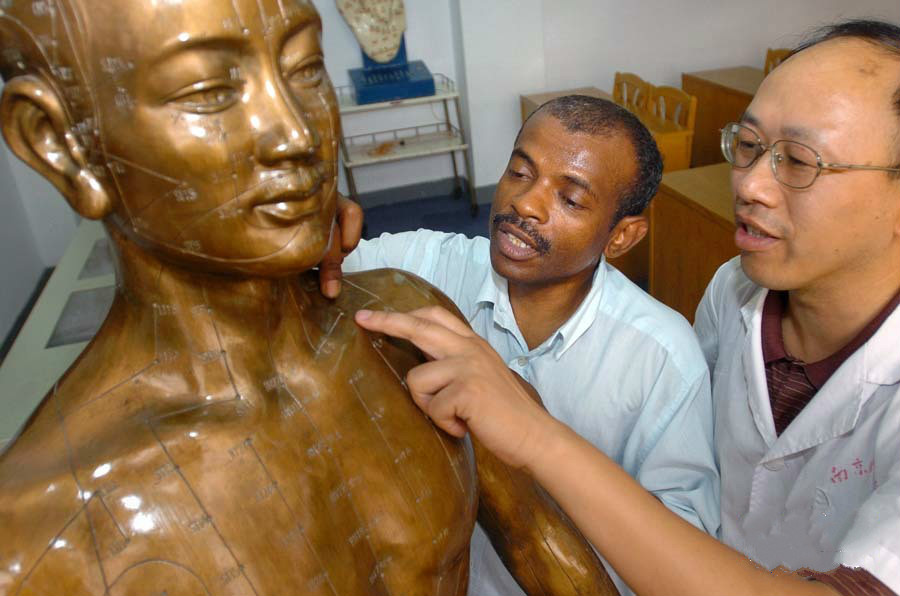Traditional Chinese medicine embraces international side

A Comorian doctor exchanges ideas of meridian acupoint diagnosis with a Chinese expert at Nanjing University of Chinese Medicine.
Early this year, President Xi Jinping visited the World Health Organization (WHO) and gave a bronze acupuncture figure as a present to the WHO. President Xi and Margaret Chan, the director-general of the WHO, unveiled this mysterious bronze statue at the ceremony.
With the release of the white paper China’s Traditional Medicine and other policies, the development of traditional medicine in China has become a national strategy and traditional Chinese medicine has won worldwide recognition. The going-out policy of traditional Chinese medicine has embraced the times.
Facts prove that the world needs traditional Chinese medicine. The vitality of traditional medicine exists in treatment concepts that are totally different from those of Western medicine. Some incurable diseases diagnosed by Western doctors may be miraculously cured by traditional Chinese medicine. Chinese therapy, combing the herbal medicine Yinqiao powder with Maxingshigan Decoction to fight H1N1 influenza, has been widely recognized by the international community. In 2011, the international leading medical journal the Annals of International Medicine published a clinical research project on the treatment of H1N1 influenza by Chinese herbs, which was regarded as a landmark moment for Chinese medicine research going global.
Traditional Chinese medicine was born in primitive society. During the Spring, Autumn and Warring States periods, theories of traditional medicine were basically formed and evolved throughout the following dynasties. Throughout history, Chinese medicine has exerted a great influence on cultural circles of East Asia. Kampo in Japan, traditional Korean medicine and traditional Vietnamese medicine developed on the basis of traditional Chinese medicine. Traditional Chinese medicine is rooted in the cosmological notions of yin and yang and five elements, which are used to explain various physiological and pathological phenomena. It regards the human body as a unity of qi, shape and spirit and uses the comprehensive analysis by the four diagnosis methods—looking, listening, questioning and feeling the pulse to find out the causes of disease.
Traditional medicine utilizes acupuncture, massage, cupping therapy, qigong, diet therapy and other treatment means to reach to the harmony between yin and yang and realize recovery. The bronze model used for this medicine is the earliest medical teaching model and human anatomy model in the world, and includes all the acupuncture points on the body.
Traditional Chinese medicine is a precious legacy that our ancestors left to us and is the key to opening the treasure house of Chinese civilization, which integrates the wisdom of Chinese philosophy and thousands of years of concepts of health and practical experience. Traditional Chinese medicine plays an irreplaceable role in traditional Chinese culture. In recent years, the demand for traditional Chinese medicine has mainly arisen from the changes of worldwide disease spectrums. Chronic non-communicable diseases are the biggest killer. Traditional Chinese medicine shows its unique superiority in preventive treatment for diseases, solves many complicated medical problems and provides Chinese prescription for global health governance. The spread of traditional Chinese medicine has reached more than 183 countries and regions, and 10 overseas traditional Chinese medicine centers have been established.
According to incomplete statistics, there are more than 1,200 organizations of traditional Chinese medicine outside of China, and half a million acupuncturists received professional training. More and more foreign doctors work in the field of traditional Chinese medicine. Statistically, 70 percent of overseas licensed doctors of traditional Chinese medicine are not Chinese, and 70 percent of their patients are foreigners. Traditional Chinese medicine flourishes abroad.
